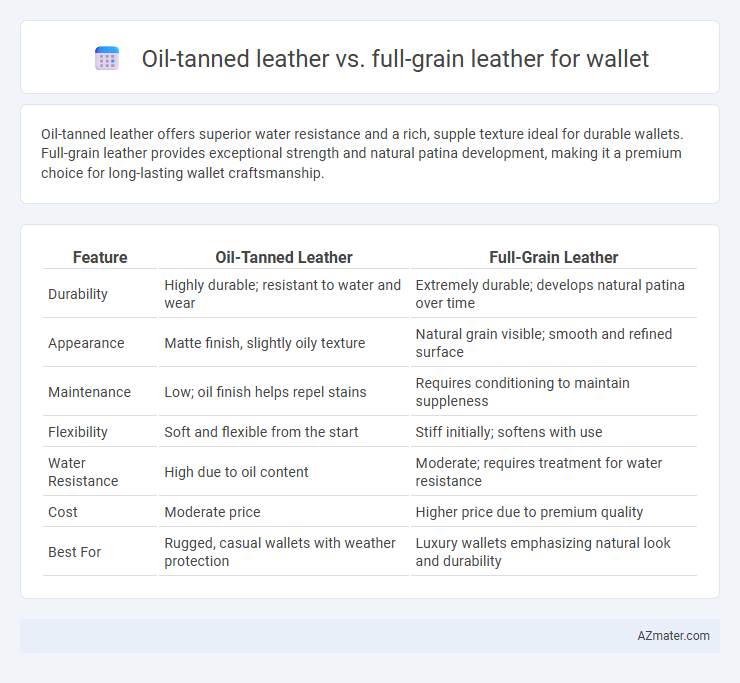Oil-tanned leather offers superior water resistance and a rich, supple texture ideal for durable wallets. Full-grain leather provides exceptional strength and natural patina development, making it a premium choice for long-lasting wallet craftsmanship.
Table of Comparison
| Feature | Oil-Tanned Leather | Full-Grain Leather |
|---|---|---|
| Durability | Highly durable; resistant to water and wear | Extremely durable; develops natural patina over time |
| Appearance | Matte finish, slightly oily texture | Natural grain visible; smooth and refined surface |
| Maintenance | Low; oil finish helps repel stains | Requires conditioning to maintain suppleness |
| Flexibility | Soft and flexible from the start | Stiff initially; softens with use |
| Water Resistance | High due to oil content | Moderate; requires treatment for water resistance |
| Cost | Moderate price | Higher price due to premium quality |
| Best For | Rugged, casual wallets with weather protection | Luxury wallets emphasizing natural look and durability |
Introduction to Oil-Tanned and Full-Grain Leather
Oil-tanned leather is treated with natural oils during the tanning process, resulting in a durable, water-resistant surface that darkens and develops a unique patina over time. Full-grain leather retains the outermost layer of the hide, preserving its natural texture, breathability, and strength, making it one of the highest-quality leathers available. The key difference lies in oil-tanned leather's enhanced moisture resistance and softness versus full-grain leather's emphasis on natural appearance and long-lasting durability.
Understanding Leather Types: Oil-Tanned vs. Full-Grain
Oil-tanned leather features a rich, supple texture achieved through the infusion of oils during the tanning process, enhancing water resistance and flexibility, ideal for wallets exposed to moisture. Full-grain leather, prized for its durability and natural patina, retains the entire grain layer, showcasing the hide's original texture and strength, which ages gracefully over time. Choosing between oil-tanned and full-grain leather for wallets depends on the desired balance between rugged water resistance and classic, long-lasting elegance.
Key Characteristics of Oil-Tanned Leather
Oil-tanned leather features a unique tanning process where natural oils penetrate deeply, offering exceptional water resistance and durability ideal for wallets exposed to rugged use. Its surface develops a rich patina over time, enhancing the leather's texture and character without compromising flexibility. Compared to full-grain leather, oil-tanned leather provides superior protection against moisture and stains while maintaining a soft, supple feel that ages gracefully.
Distinct Features of Full-Grain Leather
Full-grain leather is prized for its natural surface that retains the full grain layer, offering superior durability and unique character that develops a rich patina over time. Unlike oil-tanned leather, which is treated with oils to enhance softness and water resistance, full-grain leather maintains its original texture and breathability, ensuring long-lasting strength and resistance to wear. This makes full-grain leather wallets especially prized for their premium quality and ability to age gracefully with regular use.
Durability Comparison: Oil-Tanned vs. Full-Grain Leather Wallets
Oil-tanned leather wallets exhibit superior water resistance and develop a rich patina over time due to the oil infusion, enhancing durability against moisture and wear. Full-grain leather wallets, made from the top layer of the hide, offer exceptional strength and natural breathability, leading to long-lasting structural integrity and resistance to stretching. While oil-tanned leather excels in maintaining suppleness and weather resistance, full-grain leather provides unmatched toughness and aging character, making both materials highly durable yet suited for different durability preferences.
Appearance and Aging: Patina Development
Oil-tanned leather exhibits a rich, glossy finish with a slightly waxy texture, darkening gracefully over time to develop a deep, rugged patina that highlights natural markings. Full-grain leather features a more natural, matte surface showcasing the hide's original grain, aging by softening and evolving into a supple, unique character with a subtle sheen. Both types enhance wallet aesthetics through distinct patina development, with oil-tanned leather favoring a bolder, water-resistant patina, and full-grain emphasizing a refined, tactile aging process.
Water and Stain Resistance Properties
Oil-tanned leather offers superior water resistance due to its treatment process that infuses oils deep into the hide, creating a natural barrier against moisture and stains. Full-grain leather, while highly durable and breathable, is less water-resistant and requires additional treatments or conditioning to repel water effectively. For wallet use, oil-tanned leather provides enhanced protection against everyday spills and stains, maintaining its appearance with minimal maintenance.
Maintenance and Care Requirements
Oil-tanned leather requires regular conditioning with specialized oils or waxes to maintain its supple texture and water-resistant properties, resisting cracks and wear. Full-grain leather demands consistent cleaning and occasional application of leather conditioner to preserve its natural grain and durability while developing a rich patina over time. Both types benefit from avoiding prolonged exposure to moisture and direct sunlight to prevent damage and discoloration.
Price Point and Value Considerations
Oil-tanned leather wallets typically offer a moderate price point due to their enhanced durability and water resistance, making them a cost-effective choice for everyday use. Full-grain leather, while generally more expensive, delivers superior longevity and develops a unique patina over time, providing greater value for users seeking premium quality. The decision hinges on balancing immediate affordability with long-term investment in durability and aesthetic appeal.
Which Leather is Best for Your Next Wallet?
Oil-tanned leather offers exceptional water resistance and a soft, supple feel, making it ideal for wallets exposed to outdoor elements and daily wear. Full-grain leather, prized for its natural texture and durability, develops a rich patina over time, which enhances the wallet's character and longevity. Choosing between oil-tanned and full-grain leather depends on whether you prioritize weather resistance and softness or natural aging and robust toughness for your next wallet.

Infographic: Oil-tanned leather vs Full-grain leather for Wallet
 azmater.com
azmater.com